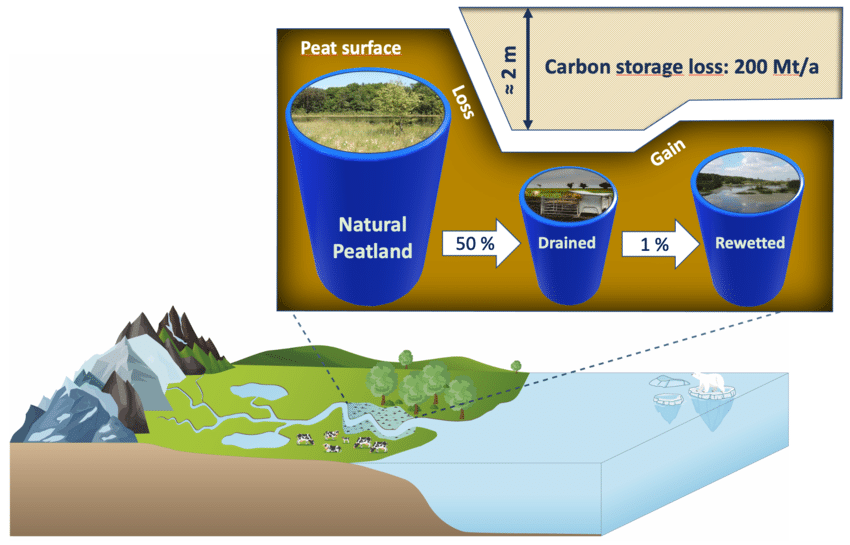Peatland Protection and Rewetting
Peatland protection and rewetting involve restoring wetlands and preventing further degradation. This approach is crucial for reducing greenhouse gas emissions, improving biodiversity, and enhancing water quality.

European peatlands gradually drained (Sciencedirect)
job openings
View open jobs in this Solution
Example Organizations
- Global Peatland Initiative - Promotes the protection and restoration of peatlands worldwide.
- International Peatland Society - Supports research and sustainable management of peatlands.
- The Nature Conservancy - Works on peatland conservation and restoration projects globally.
Overview
Peatland protection and rewetting involve restoring wetlands and preventing further degradation. This approach is crucial for reducing greenhouse gas emissions, improving biodiversity, and enhancing water quality.
Progress Made
Significant advancements have been made in peatland protection and rewetting:
- Peatland Mapping: Identifies areas needing protection and restoration.
- Drainage Control: Minimizes water drainage from wetlands to maintain moisture levels.
- Restoration Techniques: Re-establishes vegetation and hydrology in degraded wetlands.
Solutions by Sector
Conservation and Restoration
- Peatland Restoration: Reviving degraded peatlands to restore their ecological functions.
- Peatland Management: Implementing sustainable management practices to prevent further degradation.
- Peatland Monitoring: Using remote sensing and on-the-ground surveys to track peatland condition and threats.
Case Studies:
- Flow Country, Scotland: One of the largest peatland restoration projects in Europe, aiming to restore over 20,000 hectares (RSPB).
- Harapan Rainforest, Indonesia: Peatland restoration project focusing on rewetting and reforestation (BirdLife International).
- Katingan Mentaya Project, Indonesia: A large-scale peatland restoration and conservation initiative (Permian Global).
Technological Innovations
- Remote Sensing: Utilizing satellite imagery and drones to monitor peatland health and restoration progress.
- Hydrological Engineering: Designing and implementing structures to control water levels in peatlands.
- Data Analytics: Analyzing environmental data to optimize restoration efforts and track carbon sequestration.
Case Studies:
- PEATMAP Project: Global peatland mapping initiative using remote sensing technologies (Geosciences).
- MoorFutures, Germany: Carbon credit scheme for peatland restoration projects (MoorFutures).
- Wetlands International: Uses advanced hydrological modeling for peatland restoration (Wetlands International).
Environmental and Social Impact
- Climate Change Mitigation: Peatlands store large amounts of carbon, and their restoration helps reduce greenhouse gas emissions.
- Biodiversity Conservation: Restored peatlands provide habitat for a wide range of species.
- Community Engagement: Involving local communities in peatland conservation and restoration efforts.
Case Studies:
- Great Fen Project, UK: Aims to restore 3,700 hectares of fenland, enhancing biodiversity and carbon storage (Great Fen Project).
- Sundarbans Mangrove Forest, Bangladesh: Community-based peatland conservation and restoration project (IUCN).
- Congo Basin Peatlands, Central Africa: International collaboration to protect and restore peatlands in the Congo Basin (CongoPeat).
Lessons Learned
- Prevention: Preventing peatland degradation is crucial to avoid significant greenhouse gas emissions.
- Greenhouse Gas Release: Degraded peatlands release substantial amounts of greenhouse gases.
- Restoration Challenges: Restoration is slow, expensive, and not always successful.
- Importance of Peatlands: Vital tools for mitigating climate change due to their carbon storage capacity.
Challenges Ahead
- Awareness Deficit: Need for broader understanding of peatlands' role in the global carbon cycle.
- Funding Scarcity: Lack of resources for conservation and restoration projects.
- Research Requirement: Effective methods and long-term monitoring for peatland protection and restoration.
- Environmental Justice: Addressing the disproportionate impact of peatland degradation on local and indigenous communities.
Best Path Forward
- Public Awareness: Increase awareness of peatlands' importance and benefits among the public, policymakers, and stakeholders.
- Research and Development: Invest in research to improve protection and rewetting methodologies.
- Policy Support: Collaborate with governments to create supportive policies for peatland conservation.
- Financial Incentives: Provide financial incentives for peatland conservation and restoration.
- Monitoring and Evaluation: Implement robust monitoring and evaluation systems to track progress and adapt strategies.
Prominent supporters include the IUCN, UNEP, and Wetlands International.
Image credit: Sciencedirect